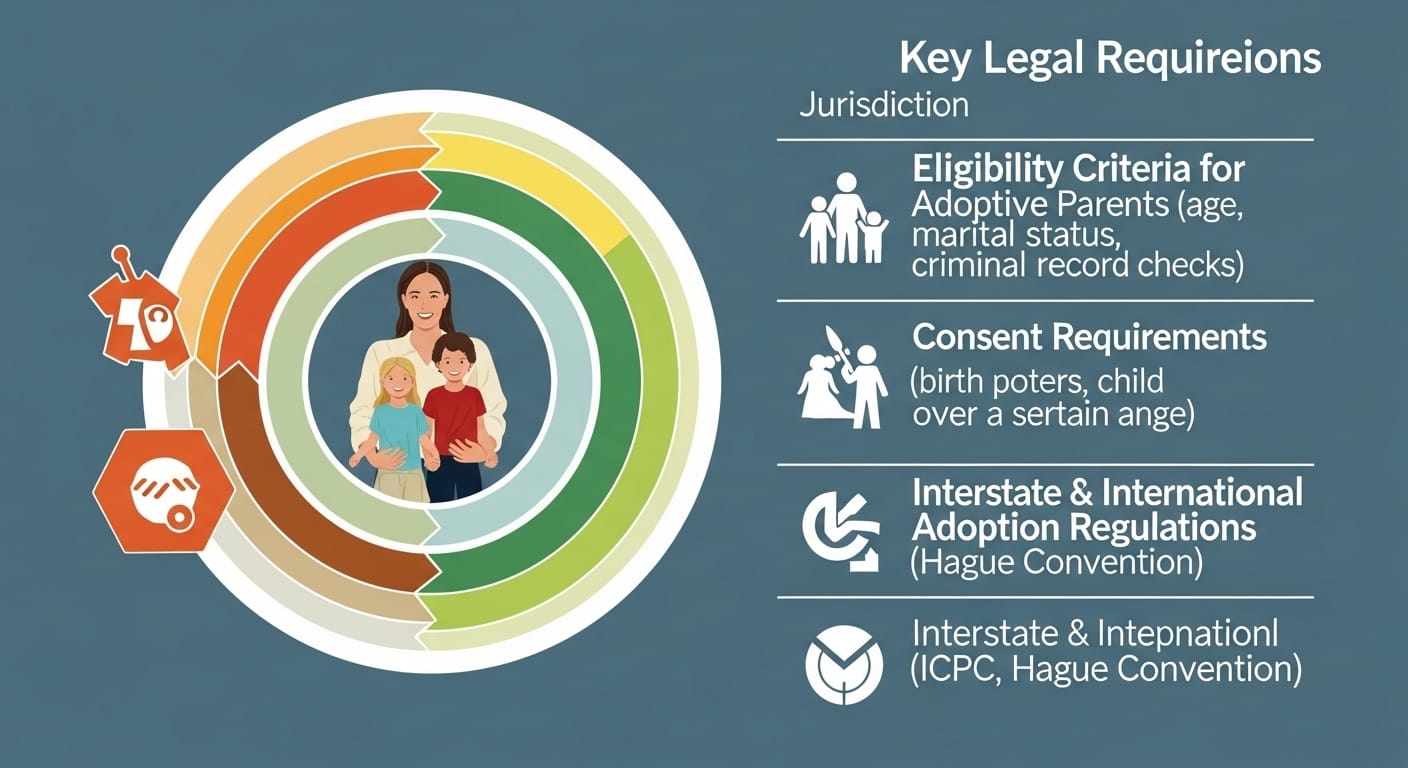Please Note: This post may contain affiliate links. If you click one of them, we may receive a commission at no extra cost to you. As an Amazon Associate, I earn from qualifying purchases.
Adoption is one of those topics that can make your heart swell and your brain hurt simultaneously. On the one hand, it’s about giving a child a loving home, which is incredible. On the other hand, the legal process can feel like navigating a maze, blindfolded, while carrying a bag of emotional bricks.
If you’re considering adoption, you’re probably full of questions like, “How do I start?” or “Why do lawyers charge so much for using big words I don’t understand?”
Adoption isn’t just about paperwork and home studies; it’s a life-changing journey. Sure, the legal jargon can be intimidating, but don’t let that scare you. Understanding the process and requirements is your first step toward building your family. So, let’s unpack the adoption process in a way that’s clear, manageable, and maybe even a little entertaining.

Top Takeaways and Key Concepts
Choose the Right Adoption Type: Evaluate domestic, international, foster care, or private adoption based on goals, finances, and paperwork tolerance.
Confirm Legal Eligibility: Ensure you meet age, health, financial, and agency-specific requirements before beginning the adoption process.
Complete a Home Study: Prepare for background checks, interviews, and home inspections to demonstrate readiness for parenthood.
Understand Legal Paperwork and Finalization: Complete all legal steps and court hearings to make the adoption official.
Plan for Post-Adoption Support: Access counseling, support groups, and resources to help your child and family adjust smoothly.
Summary of This Article
The article outlines the adoption process, emphasizing preparation, legal compliance, and support for adoptive families. It covers choosing the adoption type, meeting eligibility requirements, and completing a thorough home study. Matching with a child requires patience and careful consideration, while legal paperwork and court finalization make the adoption official. The piece also highlights the differences between open and closed adoptions and stresses the importance of post-adoption support. Financial planning and exploring available grants or subsidies are recommended to ease adoption costs and ensure a successful transition for both child and family.
Choosing the Type of Adoption

Adoption isn’t a one-size-fits-all situation. There are different paths to explore, each with its unique requirements and challenges. The most common options include domestic, international, foster care, and private adoption.
For example, domestic adoption involves adopting a child within your own country, while international adoption requires navigating another country’s rules. And trust me, international adoption can make you feel like you’re auditioning for a role in a spy movie, complete with dossiers and embassy visits.
Foster care adoption, on the other hand, involves adopting a child already in the state’s care, and it often has fewer upfront costs but may include emotional complexities.
Choosing the right path depends on your goals, finances, and, to be honest, your tolerance for paperwork. Seriously, adoption paperwork could make a tax accountant cry.
Legal Eligibility to Adopt

Now, let’s talk about eligibility. Adoption isn’t like signing up for a Netflix subscription. There are rules, and they vary by state or country. Most jurisdictions require you to be at least 21 years old, financially stable, and in good health.
Interestingly enough, you don’t have to be married to adopt. Single-parent adoptions are increasingly common, and same-sex couples can adopt in most places, though the laws vary. Some agencies also have specific requirements, like religious affiliation or parenting experience, which can feel a bit like being interviewed for the world’s most important job—because it is.
The Home Study Process
Ah, the infamous home study. If you thought an inspection from your in-laws was intense, wait until a social worker examines your home, your finances, your relationships, and probably your ability to assemble IKEA furniture.
The home study is a critical step in the adoption process. It involves background checks, personal interviews, and home visits to ensure you’re ready to provide a stable, loving environment. It’s not just about showing you have enough bedrooms; it’s about proving you can handle the ups and downs of parenting.
To be fair, it can feel intrusive, but it’s also an opportunity to reflect on your parenting goals and get guidance from professionals. Plus, once you survive it, you’ll feel like you can handle anything—except maybe potty training.
Matching with a Child
Once you’re approved, the matching process begins. This is where things get emotional, exciting, and, let’s be honest, nerve-wracking.
Matching involves finding a child whose needs align with your abilities and desires as a parent. For domestic adoptions, this might involve meeting with birth parents, while in foster care adoptions, the state often plays a more significant role.
Interestingly enough, this stage can take weeks or years, depending on various factors. It’s a bit like dating but with way higher stakes. And when you finally meet the child who’s meant to be part of your family, it’s all worth it.
Legal Paperwork and Finalization
Here’s where lawyers come in, waving stacks of documents that make War and Peace look like light reading. The legal paperwork is essential to finalize the adoption and ensure everything is above board.
Finalization involves court hearings where a judge reviews your case and approves the adoption. It’s the moment when all your efforts and patience pay off, and the child legally becomes a part of your family. Bring tissues—it’s an emotional milestone.
The Role of Open and Closed Adoptions
Adoptions can be either open or closed, and understanding the difference is crucial. Open adoptions involve ongoing contact with the birth family, while closed adoptions mean there’s no contact after the adoption is finalized.
Both options have pros and cons. Open adoptions can provide the child with a sense of identity and access to their medical history, while closed adoptions offer more privacy. Choosing the right arrangement depends on everyone’s comfort levels and the child’s best interests.
Post-Adoption Support
Adoption doesn’t end when the gavel hits the bench. Post-adoption support is vital for ensuring a smooth transition for both the child and the parents.
Support can include counseling, support groups, and educational resources to help you navigate challenges like bonding, trauma, and identity issues. Many adoptive families find these resources invaluable, especially during the first few years.
Navigating Costs and Financial Assistance
Adoption can be expensive—like, “maybe I should sell a kidney” expensive. Between agency fees, legal costs, and travel expenses for international adoptions, the bills can add up quickly.
But here’s the good news: there are grants, tax credits, and employer benefits designed to ease the financial burden. Foster care adoptions often come with subsidies to help cover the costs of raising a child.
Resources
AdoptUSKids
https://www.adoptuskids.org
Child Welfare Information Gateway
https://www.childwelfare.gov
The Dave Thomas Foundation for Adoption
https://www.davethomasfoundation.org
Frequently Asked Questions
What are the main types of adoption?
The primary types of adoption include domestic, international, foster care, and private adoption, each with unique requirements, costs, and procedures.
Who is eligible to adopt a child?
Eligibility varies by jurisdiction but typically requires the adopter to be at least 21 years old, financially stable, and in good physical and mental health.
What is involved in a home study for adoption?
A home study includes background checks, interviews, and home visits to assess the adoptive family’s readiness and ability to provide a safe, supportive environment.
How does the matching process work in adoption?
The matching stage pairs prospective parents with a child whose needs and background align with their abilities, preferences, and family structure.
What legal steps are required to finalize an adoption?
Finalization involves completing legal paperwork, attending court hearings, and obtaining a judge’s approval, officially making the child a legal member of the family.
What is the difference between open and closed adoptions?
Open adoptions allow contact between the adoptive and birth families, while closed adoptions maintain privacy and no ongoing communication after finalization.
What kind of post-adoption support is available?
Families can access counseling, support groups, and educational resources to help with adjustment, bonding, and addressing emotional or behavioral challenges.

Kevin Collier is a legal expert passionate about simplifying complex legal concepts for everyday individuals. With a focus on providing clear, practical information, he covers a wide range of topics, including rights, responsibilities, and legal procedures. Kevin aims to empower readers with the knowledge they need to navigate the legal landscape confidently, ensuring they can make informed decisions regarding their legal matters. Through insightful articles and easy-to-understand resources, he helps demystify the law, making it accessible to all.










